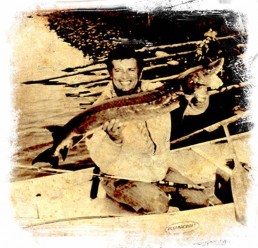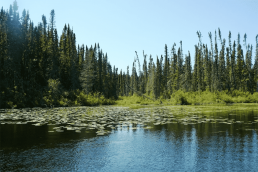Pursuing Prehistoric Fish: Sturgeon Stories
Part one: Ogoki River
The first part of our tale will be told by Dan, bringing back the memories of his first sturgeon catch ever…
Beneath the clear, copper waters of the Ogoki River, a monster migrated. He’d begun his journey 100 miles downstream. Here, at a place called Harrogate, the ugly fish staged and waited. This migration had taken place dozens of times before, but this time would see the 5-foot fish’s demise.
This day had seen the arrival of an angler as well. He’d come by float plane, bent on hunting the black ducks and Canada geese the Ogoki River system was so noted for. Knowing the walleye population of this river was easily caught, the angler had brought along his fishing gear, which included five dozen nightcrawlers. These would be used to tip his favorite jig, the Ugly Bug. Unknowingly, the ‘crawlers would be the undoing of the monster fish.
The fish, at 35 years of age, had taken up residence at a spot where the Ogoki River entered Harrogate Lake. Surrounded by dozens of black-backed, yellow-sided walleyes, the monster fish settled in, awaiting the arrival of downstream-swept crawdads, hellgrammites and dying chub minnows. The chubs had come to the sandy pockets between the rocks of the rapids to spawn next spring. In doing so, many of them were beaten up—ideal food for the large prehistoric fish.
I was the angler, the fish was a lake sturgeon, one of many which annually migrate up the Ogoki River from a large lake on the Albany River system.
With waterfowl hunting season opening the next day, I’d hold off loading my 20 gauge over and under shotgun in the 14-foot watercraft and take only my fishing gear, as I enjoyed the fresh sweet northern air as sundown approached.
Reaching structure where running water entered Harrogate Lake, I lowered a black Ugly Bug tipped with an inch of fresh ‘crawler. Moments later, while drifting with the current, a strike occurred and I had dinner, a near 4-pound walleye. That was easy! Not wanting to leave the excitement, I motored upstream and began to dabble my 1/4-ounce jig in 8 feet of water.
Suddenly, it hung up, snagged hard to the rocky bottom. Or so I thought! The Ugly Bug, a snag-free jig, made me wonder why the hang-up? So I motored upstream to get above the snag, a maneuver that should dislodge it.
Then, I felt the snag move. Maybe I’d hooked a loose sunken log. It seemed to be moving downstream with the current. Oh well, I’d just follow, lower my rod tip, and attempt to dislodge the jig.
When I got to the spot directly above the snag, it jerked and moved upstream. Maybe I’d hooked one of those 40-inch-plus northern pike the Ogoki has to offer.
An hour later, as the sun disappeared, I’d fought the monster all the way down to a point just opposite Harrogate’s cabin dock, a distance of nearly a quarter mile. Still no sighting of what I’d hooked on 8-pound line. My fight had lasted much longer than expected.
I eased the boat toward shore and the wooden dock. Surprisingly, the unseen fish came with me. The boat would be beached and the fight would continue from shore.
Twenty minutes later, as dark came on, I had the giant fish thrashing in the shore’s shallow water. Good Lord, it was a sturgeon, the first I’d ever caught. Grabbing it by its tail, the beast was dragged onto the stony beach.
This was the first sturgeon I caught but not the last one. Estimated weight was 30 to 35 pounds.
Part two: Rainy River
As we continue this tale, we switch voices, handing the pen over to “Bobber” Anne, who also knows the intrigue of pursuing sturgeon…
Seven years ago, while at the Minnesota Governor’s opener in International Falls, Dan Gapen, Sr. and I had the opportunity to fish with an old character named Don Piekarski. The DNR had selected Don to be our guide for the weekend. The crappie spawn had failed to materialize on Rainy Lake, and I was in no mood to chase the slow-biting walleyes of the region.
The subject of sturgeon came up, and I jumped at Don’s suggestion that we might give the sturgeon run on the Rainy River a go. Don claimed they were at the peak of their run and we’d stand a good chance of catching more than one.
Dan’s memories of the day on the Ogoki flooded back. It was fun to hear him talk about it as we pulled up on the first spot.
“Drop the anchor,” came the command from our guide, as he settled the boat where the Little Fork River entered the Rainy River.
“Sturgeon divide their run right here,” Don explained to us, “as they make the decision to migrate up the Little Fork or go on up to the dam at International Falls.”
We’d use 2-ounce Bait Walker sinkers with a huge gob of nightcrawlers threaded on a 3/0 size hook. Rod and reel outfits would be those used for pike or bass, but Don suggested we use 80-pound Kevlar line. We elected to use the 20-pound Dacron we had brought with us.
It was a warm spring day. A sit-and-wait period began, but we didn’t have to wait long. My glob of ‘crawlers had rested on the bottom only 15 minutes when my rod signaled the tap-tap of a strike. As instructed, I dropped my rod tip back, then struck hard to set the hook.
Line ripped from the reel and a huge surface explosion erupted. A 4-foot sturgeon went skyward, a normal occurrence with these fish. But interestingly, Dan’s earlier encounters with this fish on the Ogoki had failed to see a single fish break water.
It took 10 minutes to bring the beast to boat. Don expertly grabbed its tail and lowered the first sturgeon aboard. It was a female, and black roe leaked from it as my partner instructed how I should lift it for a photo. We had arrived during the spring spawn.
Dan was next to hit a fish, a 62-incher; then Don with a 65-incher, both females. Where were the males? Don informed us the males, a smaller fish, had preceded the females and were probably at the first waterfalls on the Little Fork.
We continued to battle and bring to boat 12 prehistoric specimens that day, the largest a 69-incher, the smallest a 24-inch, late-arriving male. All fought a deep-water battle before coming to hand. Ten of these, mostly the larger fish, broke water. All were caught on nightcrawlers, but toward the end of the day, Don added a shiner to the gob of ‘crawlers as a special enticement, a trick he’d learned years before.
As you read this, the sturgeon run is on along Minnesota’s northern border. It doesn’t take much for you to get in on the action. A rod you would use for bass, pike, or muskies, 20- to 40-pound line, a 2-ounce Bait Walker sinker, a 3/0 curved, short-shank hook, and three to five dozen ‘crawlers. I urge you to give it a go. One giant sturgeon will create memories lasting a lifetime.
MWO
SHARE THIS POST
Did you enjoy this post?
You can be among the first to get the latest info on where to go, what to use and how to use it!
Dan Gapen
Considered one of the world’s leading river anglers, Dan Gapen, Sr. has shared his knowledge with MidWest Outdoors readers and viewers for more than 40 years. He is a member of all three Fishing Halls of Fame—International, National Freshwater, and Minnesota. He has an immense grasp of the world’s fisheries. He may be contacted at 877-623-2099.
@TheGapenCompany.



